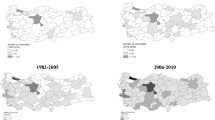Abstract
This paper reports the results of an empirical study on the impact of three proximity measures: geographical distance, thematic distance and socio-economic distance among the set of 45 scientifically most advanced countries on their cooperation network.
In network data, individuals (viz. countries) are linked to one another and the relationships are nested and embedded in groups, with the result that statistical assumptions of independence underlying ordinary least squares regression are systematically violated. Hence, we have used a non-parametric regression procedure, Quadratic Assignment Procedure (QAP), for regressing the matrix of transnational cooperation on the matrices of three proximity measures: geographic proximity, thematic proximity and socio-economic proximity. The results indicate that all the three proximity measures have the expected negative effect on transnational cooperation. Geographic proximity has greater impact than the other proximity measures.
Similar content being viewed by others
References
ALLEN, T. J., A. R. FUSFELD (1975), Research laboratory architecture and structure of communications, R & D Management, 5: 153-164.
BAKER, B., L. J. HUBERT (1981), The analysis of social interaction data: A nonparametric technique, Sociological Methods and Research, 9: 339-361.
BEAVER, D. De B., R. ROSEN (1979), Studies in scientific collaboration, Part I: The professional origins of scientific coauthorship, Scientometrics, 1: 65-84; Studies in scientific collaboration, Part II, Scientific coauthorship, research productivity and visibility in the French scientific elite, 1799-1890, Scientometrics, 1: 133-149; Studies in scientific collaboration, Part III: Professionalization and the natural history of coauthorship, Scientometrics, 1: 231-245.
BORGATTI, S. P., M. G. EVERETT, L. C. FREEMAN (1999), UCINET V for Windows: Software for Social Network Analysis, Natick: Analytic Technologies.
BRAUN, T., W. GLÄNZEL, H. GRUPPE (1995), The scientometric weight of 50 nations in 27 science areas, 1989-1993, Part I, All fields combined, Mathematics, Engineering, Chemistry and Physics; Scientometrics, 33: 263-293; Part II, Life Sciences, Scientometrics, 34: 207-211.
CABO, R. G. (1994), THE Knowledge Network: European Subsidized Research and Development Cooperation, Labyrint Publications.
DOBROV, G. M. (1990), A strategy for organized technology, In: J. FARKAS, Sociology of Science and Research: Akadémia Kiadó, Budapest.
HUBERT, L. J., R. G. COLLEDGE (1981), A heuristic method for the comparison of related structures, Journal of Mathematical Psychology, 23: 214-226.
HUBERT, L. J., J. SCHULTZ (1976), Quadratic assignment as a general data analysis strategy, British Journal of Mathematical Psychology, 9: 190-241.
JUDGE, G. G., W. E. GRIFFITSH, R. C. HILL, H. LUTKEPOHL, T. LEE (1990), The Theory and Practice of Econometrics, New York: John Wiley and Sons.
KATZ, J. S. (1994), Geographical proximity and scientific collaboration, Scientometrics, 31: 31-43.
KRETSCHMER, H. (1999), Development of structures in co-authorship networks, In: P. S. NAGPAUL, K. C. GARG, B. M GUPTA (Eds), Emerging Trends in Scientometrics, New Delhi: Allied Publishers. NAGPAUL, P. S. (1997), Science beyond Institutional Boundaries: Transnational Linkages of Indian Science, National Institute of Science Technology and Development Studies, New Delhi.
NAGPAUL, P. S. (1999), Visualizing changes in the global network of science, In: Proceedings of the Seventh International Conference on Scientometrics and Informetrics, Colima, Mexico.
NARIN, F. S., E. S. WHITLOW (1990), Measurement of Scientific Cooperation and Coauthorship in EEC-Related Areas Of Science, Vol 1. Commission of the European Communities (EUR 12900 EN).
PRUTHI, S., P. S. NAGPAUL (1978), Pattern and Role of Informal Communication in R&D, Monograph 1/78, Centre for Studies of Science, Technology and Development, CSIR, New Delhi.
SCHOTT, T. (1998), Ties between center and periphery in the scientific world-system: accumulation of rewards, dominance and self-reliance in the center, Journal of World Systems Research, 28: 112-144.
WORLD BANK (1995), World Development Report.
ZIMAN, J. (1994), Prometheus Bound: Science in a Dynamic Steady State. Cambridge: Cambridge University Press.
Author information
Authors and Affiliations
Rights and permissions
About this article
Cite this article
Nagpaul, P.S. Exploring a pseudo-regression model of transnational cooperation in science. Scientometrics 56, 403–416 (2003). https://doi.org/10.1023/A:1022335021834
Issue Date:
DOI: https://doi.org/10.1023/A:1022335021834



